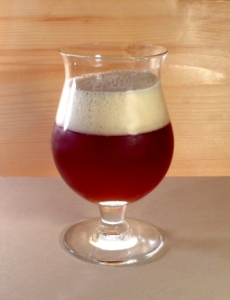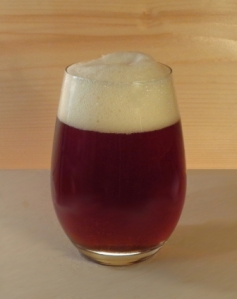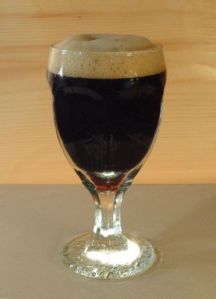
Subscribe to continue reading
Subscribe to get access to the rest of this post and other subscriber-only content.

Subscribe to get access to the rest of this post and other subscriber-only content.
 This is a classic Belgian dark tripel. If you have tried Brouwerij Van Steenberge’s Gulden Draak, you know what I mean. Buccoleon Strong Ale is a tribute to that world-class beer.
This is a classic Belgian dark tripel. If you have tried Brouwerij Van Steenberge’s Gulden Draak, you know what I mean. Buccoleon Strong Ale is a tribute to that world-class beer.
Brewed with Belgian Strong Ale yeast, it offers flavors of raisins, plums and pears, together with spicy hints of cloves, rum, and nutmeg. Starting with a Pilsner malt base; wheat malt, cara-wheat, crystal malt, biscuit/aroma malts and caramely golden syrup provide a flaky crust for this virtual fruit tart. The yeast leaves its distinctiver mark.
As it is not a Gulden Draak clone, it is a bit drier and a little more bitter. Its original gravity of 24.5 Plato (1105) still leaves a lot of residual sweetness, so it is refermented in the bottle with Champagne yeast and no added bottling sugar. Age this one at least a year.
Gulden Draak is named after the golden dragon at the top of the belfry of Ghent. The story of how he got there is fascinating. Buccoleon was the dragon’s name. He lived in the swampy ground around Aleppo, one of the chief cities of the Saracens in northern Syria. He was such a tender-hearted old dragon that he was called The Weeping Dragon. He wept bucketfuls of tears when Belgian crusaders and the Saracens fell to fighting. Where his tears fell, beautiful flowers began to grow.
A crusader took their bulbs back to Belgium, where they became famous for being the most beautiful tulips of all. Hearing about their fame, Buccoleon, whose scales had turned to gold because the crusaders had left, flew to Belgium to see for himself. He decided to stay!
 This is a beer that answers the question “What would it be like to brew up a batch of oatmeal raisin cookies?”
This is a beer that answers the question “What would it be like to brew up a batch of oatmeal raisin cookies?”
In the past, the term “stout” referred to a beer that was extra strong. Thus, we had Porter, and we had Stout Porter, which eventually became just Stout for short. Interestingly, what is now known as Stout is oftentimes rather low in alcoholic content while Porters tend to have an ABV of 5.5% to 6% or more. But historically, Stout was any beer that was as strong as the drinkers that were expected to consume it.
To make this brown stout, start with the ingredients for cookies: wheat malt, oats, sultana raisins. Add to this Maris Otter base malt, crystal malt, a touch of caramel rye malt, and some Cara Munich. Mash at a fairly high temperature to encourage the production of unfermentable sugars that will keep the brew more sweet and full-bodied. Magnum and Amarillo hops are assertive without being overpowering. Add golden syrup at the end of the boil to contribute more caramel flavors. Ferment with a fruity yeast such as London Ale. Soak sultanas in dark rum until they are soft, then whirl the mixture in a blender. Add some to the primary fermenter, and another batch to the secondary, along with a hint of vanilla extract.
The result is not so much a beer that tastes like oatmeal raisin cookies as it is an oatmeal raisin cookie that tastes like beer.
 The Cascade Mountain Range extends from Southern British Columbia through Western Washington and Oregon, into Northern California. Part of the Pacific Ocean’s “Ring of Fire” its highest peak is the volcano Mount Rainier. To its west are the hipster havens of Seattle and Portland, famous for some of the finest craft beer in the world. To its east lies the fertile hop growing region of the Yakima Valley in Washington. South of Portland, at the western edge of the Cascades, another stretch of fine hop farms fills the Willamette River valley.
The Cascade Mountain Range extends from Southern British Columbia through Western Washington and Oregon, into Northern California. Part of the Pacific Ocean’s “Ring of Fire” its highest peak is the volcano Mount Rainier. To its west are the hipster havens of Seattle and Portland, famous for some of the finest craft beer in the world. To its east lies the fertile hop growing region of the Yakima Valley in Washington. South of Portland, at the western edge of the Cascades, another stretch of fine hop farms fills the Willamette River valley.
The Cascade Range and its surrounding hop and barley farms form the mythical country of Cascadia. A generous cartographer would include the barley-growing regions of the Columbia Basin, and the Palouse, stretching east and south from Spokane, Washington. It also makes sense to declare San Francisco an honorary member among Cascadia cities, for it is the birthplace of the modern craft beer movement in the United States, thanks to the visionary efforts of Fritz Maytag and his Anchor Brewing Company.
The strains of hops developed in Cascadia, fittingly often begin with the letter “C” themselves. The “Four C’s” as they are sometimes called, are Cascade, Centennial, Chinook and Columbus. More recently Citra ™ has joined the group. They are dominantly bright, piney, citrusy and resinous in taste and aroma, and form the basis of most American India Pale Ales. Recently, they have been incorporated into a style known as Cascadian Dark Ale.
As hop and barley production began to ramp up in Cascadia during the 1980s, another development took place 180 degrees away in the Ring of Fire. Japanese brewers were early to recognize the potential for product differentiation offered by creating all-malt lagers in their commercial operations. Kirin and Sapporo led the way with premium “black beer” (黒ビール), featuring roasted malts and a sweet finish.
The Cascadia Black Lager shown here pays homage to both sides of the Ring of Fire. It is hoppy (40 IBU) like a Sierra Nevada Pale Ale, slightly roasty like a dark ale, with mildly sweet maltiness like Japanese black lager. It uses the San Francisco lager yeast to keep the finish drier than a typical ale. Cold-infused specialty grains, including debittered Carafa II, Munich malt and Breiss Special Roast maximize flavor while keeping away excessive burned harshness. A nice thick head leads to a moderately full mouth feel, and its 5.7% ABV is assertive, while keeping it well within the range of sessionability for the discerning and determined tippler!

A cream ale for breakfast. Not meant to replace your double espresso, but rather to stand beside it, bracing you for the day to come.
Cream ale emerged in the late 19th Century United States when ale breweries, faced with immigrant competition from Bavarian brewers bringing lager to the market, devised a light and refreshing, yet bold concoction that combined the crisp, dry flavor of a lager with the rapid fermentation characteristics of an ale. In many of these renditions, a substantial ABV approaching 5.5% was a feature.
This cream ale uses 22 IBU of Comet hops, a variety that tastes and smells remarkably like pink grapefruit. Breakfast cereal included: organic corn grits, and steel-cut oats, along with some nice caramel notes from a variety of crystal malts. Starting gravity is 15 Plato, boosted by a late addition of rice syrup solids. White Labs WLP080 Cream Ale yeast blend provides crisp yet round fermentation notes. Dry hopping with Comet offers grapefruit aroma.
This is a fruity breakfast drink; cream of corn grits with fruit and oats, delivered with the full mouthfeel of an ultimate smoothie.
 Depending on where you live, it’s not to late to get out in the woods and gather some elderberries. They make a nice wine of course, but they also make a tart and fruity beer. An elderberry braggot (beer and mead hybrid) is also a tasty possibility. The berries are the fruit of Sambucus species. In Europe, they come most commonly from the Dwarf Elder (Sambucus ebulus.) This tree was known as the Ebull in ancient times, the term taken from its Latin name. The beer made from elderberries is called Ebulum, and appears as a recipe in books from the early 1700s. The Oxford Dictionary defines ebulum as a name for elderberry wine, but London & Country Brew III (1743) says “make a white Ebulum with pale Malt and white Elder-berries.” This was possibly a barley wine.
Depending on where you live, it’s not to late to get out in the woods and gather some elderberries. They make a nice wine of course, but they also make a tart and fruity beer. An elderberry braggot (beer and mead hybrid) is also a tasty possibility. The berries are the fruit of Sambucus species. In Europe, they come most commonly from the Dwarf Elder (Sambucus ebulus.) This tree was known as the Ebull in ancient times, the term taken from its Latin name. The beer made from elderberries is called Ebulum, and appears as a recipe in books from the early 1700s. The Oxford Dictionary defines ebulum as a name for elderberry wine, but London & Country Brew III (1743) says “make a white Ebulum with pale Malt and white Elder-berries.” This was possibly a barley wine.
Elderberries have a long history of medicinal use, with a reputation for successfully treating colds and flu. For this purpose they are usually made into a syrup. The raw berries are somewhat toxic, and so they are cooked. Elderflowers also have medicinal and culinary uses, notably as a background flavoring for the cordial Sambuca.

This Ebulum has a Chocolate Surprise. In addition to the pale malt (in this case Maris Otter) in traditional recipes, this one has chocolate malt, an English blend of crystal malts, and Dingeman’s debittered black malt. It is spiced with elderflowers, grains of paradise, and cinnamon, finished with Muscovado sugar at flameout. A touch of lactose added just before bottling creates a full mouthfeel and a bit of residual sweetness that balances the berries’ tartness.
Stripping two kilos of elderberries from their elaborate stems is tedious work. Drinking the results after a year of aging is a delectable reward.
The tamazcal (Nahuatl for “house of heat,” or possibly Aztec for “bath house”) is a sauna-like structure invented by the pre-Columbian inhabitants of Central Mexico, and the region south to present-day Costa Rica. These structures are still in use, performing a similar function as that of a sweat lodge or steam room.
Starting around 7000 BCE, complex agrarian cultures began to form in this region, along with the creation of sedentary agricultural villages, and ceremonial centers. Purification rituals were among the curative ceremonies performed by these indigenous people, designed to rejuvenate the body after battle or a ball game.
Along with the heat therapy provided by the tamazcal, many practitioners suggest imbibing in another source of HSPs: Opotunia-Ficus-Indica, or prickly pear cactus. The fruit is high in antioxidants, particularly betalains (betanin and indicaxanthin), two molecules that give the juice its nearly fluorescent red color. With a flavor reminiscent of watermelon, the juice is rich in Vitamin C, and is one of the first cures for scurvy! The plant also contains at least five other antioxidant flavinoids. The pulp of the fruit contains the carbohydrates glucose, fructose and starch, proteins, and fibers rich in pectin.
Eleuthero root (Eleutherococcus senticocus)is a medicinal plant native to northeast Asia. It is often referred to as Siberian Ginseng, as it is widespread in North Korea and throughout Northeastern Russia. It is not the same as Panax ginseng, the more common Chinese herbal medicine. Eleuthero is considered an anti-oxidant “adaptogen” that reduces the impact of stress, while stimulating the central nervous system.
Rooibos or “red bush” (Aspalathus linearis) is a broom-like legume growing in the fynbos (shrubland) of the Western Cape of South Africa. The leaves of the plant are used to make a bush tea, which has been popular there for generations. Rooibos leaves are oxidized (“fermented” in tea parlance) to create their red color and complex flavor. They are high in Vitamin C and antioxidant flavonoids. Cinnamic acid gives them a honey-like aroma. Rooibos has a bitter/sweet taste that has been described as slightly pungent and “warm.”
These three ingredients combine in Tamazcal Opotunia with citrus juice and zest to create a potent tonic, cleansing indeed but also a refreshingly cool end to a steamy session in a tamazcal, a hammam, or just a hot August night.
Have you noticed the proliferation of enticing labels in the craft beverage section of your grocery store or liquor outlet? Perhaps you’ve also noticed the breathtaking prices commanded by these handcrafted drinks. Fermentation master and author Robert Rivelle George certainly did, and decided to share his knowledge with those who enjoy craft drinks but balk at their cost.
His new book The Umami Factor: Full-spectrum Fermentation for the 21st Century, takes on the task of instructing the aspiring or seasoned craftsperson in the secret to creating full-flavored, satisfying beverages at home, the way it was done for centuries.
Umami is the fifth taste, existing alongside the better-known sensations of sweet, sour, salty and bitter. It is the savory taste of amino acids ubiquitous in foods such as yeast, grains, fruit, and roasted meat and vegetables. By exploiting the taste sensation of Umami, a craft-beverage enthusiast can create savory, mouth-watering drinks of all types, hard or soft.
Released this May by Schiffer Publishing, Robert’s book The Umami Factor features a foreword by brew master Norm Chapman of Spencer Hill Cottage Brewery in Grand Forks, and more than 100 color illustrations. These accompany 75 original recipes for beverages spanning the gamut of soft drinks, beer, wine, sake, cider, mead, and even hard liquor. Mr. George explores ancient to modern techniques for producing these beverages, while offering a philosophical perspective to their creation and enjoyment.
“Robert’s philosophic approach to brewing in The Umami Factor is more of a lifestyle than a hobby,” says Maarten Lammers, owner of Nelson’s Art of Brewing. “He has a sense of humor that leaves you laughing out loud. I read with the eyes of a novice, and the eyes of a scientist, and I’ll certainly use the recipes, which are delicious.” Harry Davidson of HD Ventures adds “Like any good book there is drama, intrigue, inebriation, and sex. A complete reference guide to brewing, rich with recipes, menus, instructions and photographs, it leaves no stone unturned.”
History includes a long tradition of brewing, vintning and craft pursuits of all types. The Umami Factor presents a unique way to follow those crafty impulses, and amaze and impress your friends. Robert’s recipes are complex, for you can’t create a complex flavor sensation without a complex recipe. But the book also suggests easy ways to improve even the most prosaic of concoctions. Beginner and expert alike can find very many ways to challenge themselves.
“These are the creations of a man who is a master of his craft. Read this book carefully and keep it by you. You will be a better brewer as a result.” — Norm Chapman, Brew Master, Spencer Hill Cottage Brewery
WHAT IS THE UMAMI FACTOR?
It’s two things. It’s the title of my new book, and it is the principle for making fermented beverages that provide a complex, mouth-filling, satisfying flavor sensation by balancing multiple aromas with the five tastes: sweet, sour, bitter, salty and umami.
WHAT IS UMAMI?
Umami is the taste sensation of savory foods. The word is Japanese for “delicious” taste. It’s provided by receptors in your mouth, throat, esophagus, and even stomach that detect the presence of glutamates, which are derived from amino acids. The umami sensation is pleasant for the same reason that “sweet” is pleasant.
The body is cued to detect vital, high-engergy nutrients: carbohydrates with sweet taste, and proteins with umami taste. Natural, unfiltered fermented beverages are packed with umami-producing compounds from the fruits, grains, and yeast they are made of.
WHAT IS FULL SPECTRUM FERMENTATION?
Full-spectrum fermentation describes a process of techniques combined with intricate ingredient formulas that create complex flavor arrangements evoking the response “There’s so much going on there! How did you do that?”
Full-spectrum beverages are complex and improbable, but ultimately well-balanced drinks.
It takes a full-spectrum look at beverages from soft drinks to hard liquor. It thoroughly discusses the components necessary for flavor balancing. It examines related spectra, such as the inebriation spectrum and the commitment spectrum. It has a textbook approach to data, with a multitude of tables for ingredients and supplies. It provides recipes and detailed instructions, but more importantly it is a call to chefdom for aspiring fermentation artists. Tally Ho!
Buy The Umami Factor now for a substantial pre-release discount here.
You’re about to be introduced to the UMAMI factor, the secret to sensational homemade beverages, including spirits, wine, beer, soft drinks, kombucha, and more. Chances are you may not have heard of umami, the taste impression created by certain amino acids in a food or beverage. Now you know. Starting the novice off right with a thorough understanding of “full-spectrum” fermentation theory,the book dives into the various preparation techniques and shows how umami-producing ingredients create beverages with a sensation of balance and roundness on the palate, tongue, nose, and even throat. More than 75 recipes, including all the beverages here, plus sharp insight, and handy tips help the amateur fermentation chef conquer the next frontier in beverage science. Even the most experienced of fermentation aficionados will discover a philosophical yet practical approach to further exploration. Pre-order now from Amazon.com and save 21% over the cover price!